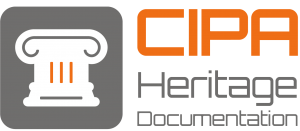Newsletter 11
January 2017
Editors view
Dear All,
The CIPA newsletter reached issue no.11. The CIPA newsletters from now and on will be released through our website as an embedded structure. Together with our webmaster, Geert Verhoeven, we worked to establish this (new) newsletter appearance. We are very delighted for this, but we will be happier if you have your feedback; how did you find it?; how can we improve it?; … Your view is more than welcomed.
CIPA 2017 is approaching. You still have some time to submit your extended abstracts and full papers deadline; 15 February 2017 is the final deadline to submit your contributions. The local organizing committee, namely Mario Santana, Stephen Fai, Christian Ouimet, James Hayes, Stephen Vickers, is working hard to arrange everything and on time. Please do not forget to visit the symposium website regularly to get updated information.
This time I want to make a reference to a person who offered so many to CIPA and continues to offer. Antonio Almagro has been awarded the Spanish National Prize for Restoration and Conservation of Cultural Heritage 2016. Antonio is a CIPA Honorary Member. For more information, please visit the relevant web page (in Spanish).
In this issue, we are promoting articles, news and events, publications, and the activity from our sustaining members which continue to support us.
We do need your continuous support to further proceed. Your input is very important to collect and disseminate the necessary information in the area of cultural heritage documentation worldwide. Please send us your contribution and it will be included in the next e-newsletter. You can consider articles, news, events, publications, projects, books’ review, etc. related to cultural heritage documentation.
Enjoy reading our new e-newsletter!
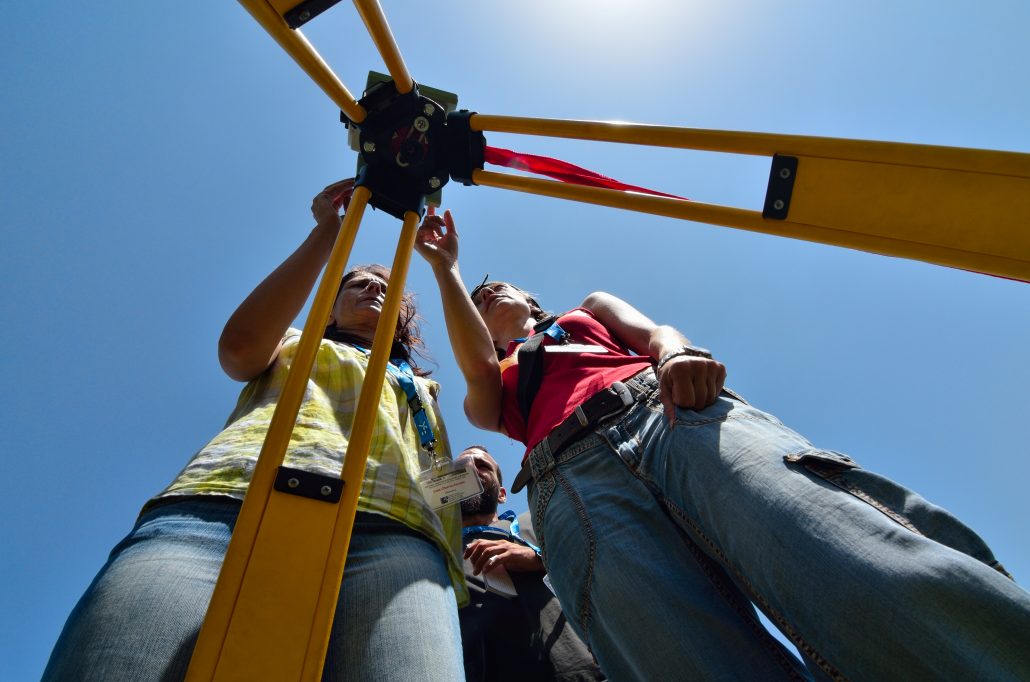
Efstratios Stylianidis
Geert Verhoeven
stratos@geoimaging.com.cy
Work in Progress on the Palatine
In 2009, in Rome, on the Palatine, Italo-French excavations brought to light the remains of cenatio rotunda, the rotating dining room in Nero’s palace. This building, known by an ancient text, boasts remarkable features, both from the architectural point of view and in terms of the scientific and technical knowledge the architects who built it undoubtedly possessed. Serving the double purpose of scientific interest and heritage conservation, the institutions involved in research wish to carry out one last excavation campaign in 2017, so as to gather all the information that the field may still provide. Indeed, the Italian government decided to turn this building into one of the main features in the newly developed Forum-Palatine archaeological park.
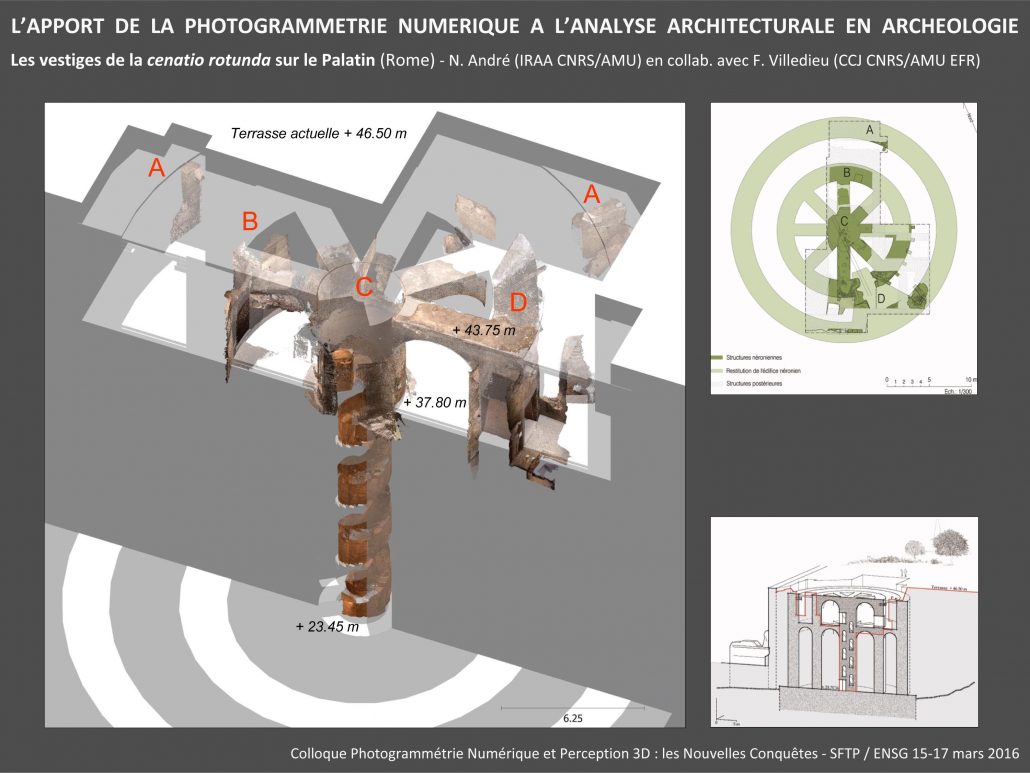
One of the main techniques used for developing the discovery was digital photogrammetry. The first experiments with this tool began in 2014, involving two students from the ENSG (École Nationale des Sciences Géographiques). Since then, this approach was improved in order to adapt it to the specific case of the Neronian building. This first approach made possible an assessment of all the advantages archaeologists can derive from using 3D modeling: it allows them both to hone the study of remains and to have at their disposal documents that play a crucial part in the interaction with the general public.
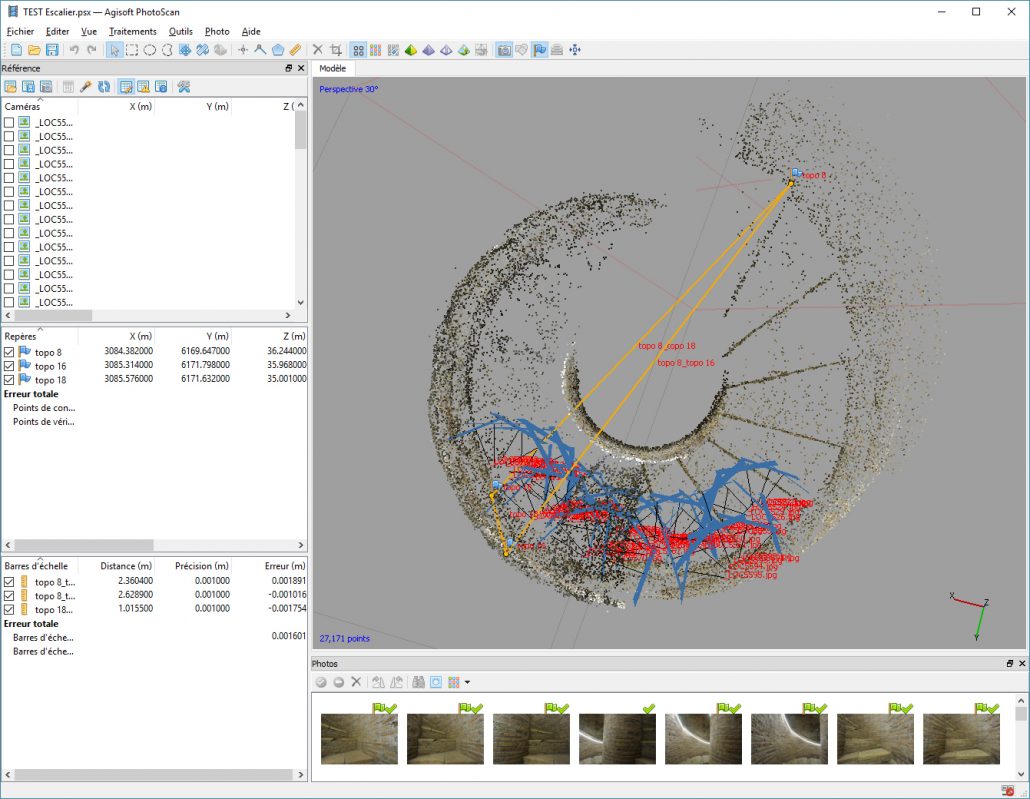
Following a first photogrammetric acquisition at the scale of the building, in July 2016 we set about creating a detailed digital model of the spiral staircase embedded in the central pillar. This cramped space, made of a central core (90 cm in diameter) around which spiral 62 steps (75 cm wide) up to a 14 m height, lacks any natural lighting. This ongoing work is the fruit of a close collaboration between photographers, topographers, architects and archaeologists, which is necessary to working out an acquisition method that will take into account both working conditions and goals.
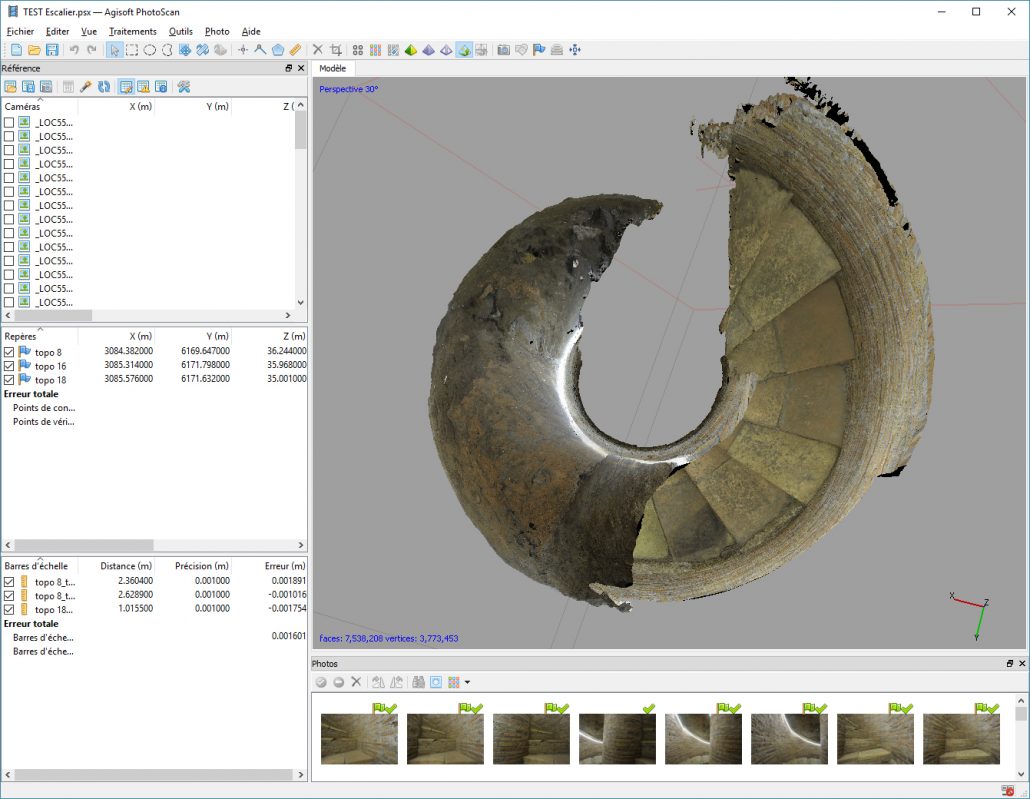
Considering the quality of the first results, we are pretty much willing to keep working in that direction, especially as one of our aims is to make possible a virtual visit of the whole remains of this stately building, with a view to sharing this discovery with the general public, which will not be able to get access to certain spaces for security reasons.
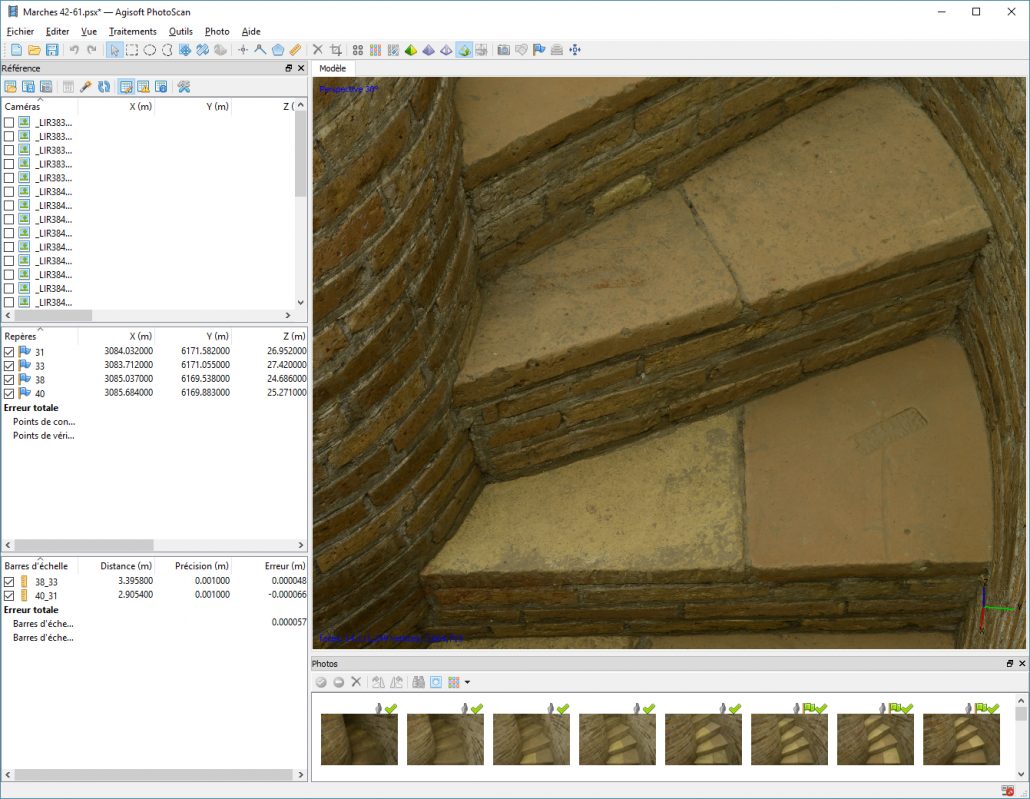
Nathalie André and Françoise Villedieu (IRAA/CNRS-AMU)
Loïc Damelet and Lionel Roux (IRAA/CNRS-AMU)
Stéphane Abellon and Nathalie André (IRAA/CNRS-AMU)
nathalie.andre@mmsh.univ-aix.fr and francoise.villedieu@gmail.com (IRAA/CNRS-AMU)
Keeping up the memory of the temple mount in Jerusalem
The protection and preservation of cultural heritage entails sustainable ways of keeping up the memory of culturally important sites and monuments. UNESCO, the organization for education, science and culture under the United Nations, has a duty to uphold without any bipartisanship sustainable scientific standards to cherish memory of places that are important to various groups of people.
It was a most deplorable act of the UNESCO’s World Heritage Committee to erase last October the name of the Temple Mount of Jerusalem, a World Heritage Site, from the UNESCO documents. Erasing history and memory from written sources can be compared to material destruction. It is natural that the site that is holy to the three great monotheistic religions should all share the historical memory of this place.
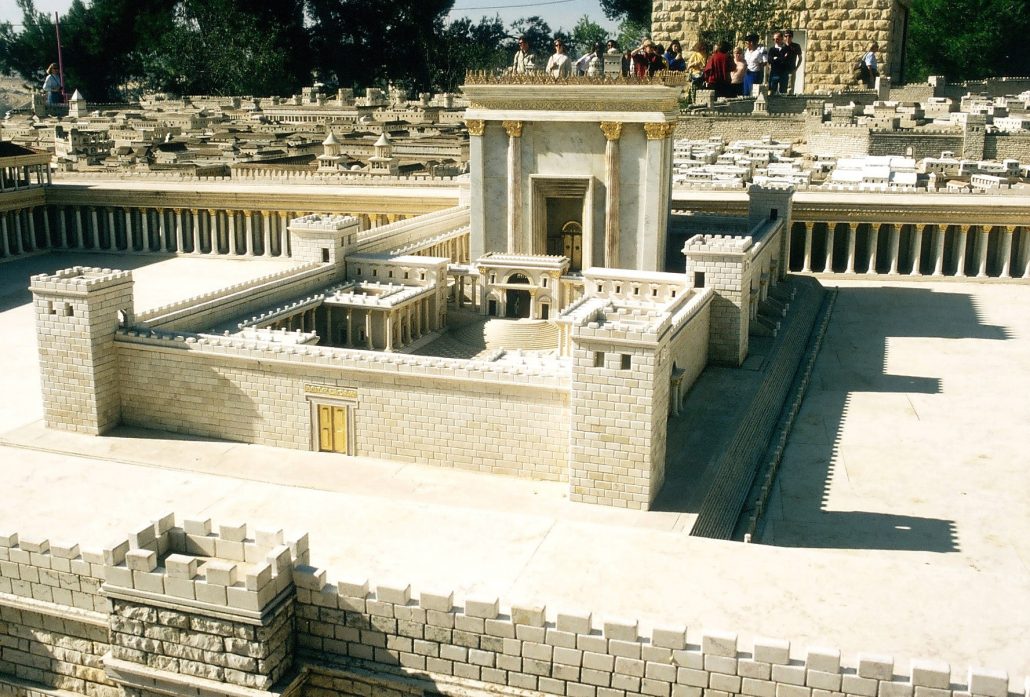
The archaeological site known as the Temple Mount or Haram in Jerusalem has its layers that have accumulated through time, and scientifically each layer is equally important. Therefore, as the name Al-Haram al-Sharif is meaningful for the Muslims, equally significant is the name of the Temple Mount is to the Jews and Christians.
Not far from Jerusalem, Palmyra has unfortunately been retaken by ISIS that had destroyed its monuments such as the Temple of Bel, the Temple of Baalshamin, the Triumphal Arch and tower tombs were blown up by these Islamic jihadists in 2015. The Russians aiding the Syrian government troops captured the site in 2016, but now at the end of the year 2016 we have seen the return of the jihadists.
Interestingly, the Temple of Bel stood the test of time for nearly 2000 years. It had been built in AD 32 and had a contemporary building of the same magnitude in Jerusalem at the time. The Temple of Jerusalem was built by Herod the Great some decades before the Temple of Bel. Herod had erected a huge man-made platform raising the Temple Mount, some of the structures of which are still visible in the so-called Wailing Wall.
Both the Temple of Jerusalem and the Temple of Bel were contemporary Semitic temples of central importance, the cellas of which had large surrounding temenoi, cultic courtyards bordered with colonnades. The Temple of Jerusalem was destroyed in AD 70 by the Romans while the Temple of Bel in Palmyra still survived until AD 2015.
Any professionals, like the members of ICOMOS, agree that the resolutions on the cultural heritage should be laid out on scientific documentation and historical facts, especially by the organizations, the purpose of which is scientific and cultural safeguarding of the heritage of mankind, not political maneuvering. Therefore, it is understandable that Irina Bokova, the head of UNESCO, has condemned the one-sided decision to only refer to the site of the Temple Mount in Jerusalem by its Muslim name Al-Haram al-Sharif decided by the World Heritage Committee.
Minna Silver
mlonnqvi61@hotmail.com
2017 Reflections – Some thoughts about CIPA
In my presentation of the CIPA report during the ISPRS General Assembly during the ISPRS Congress last July, I concluded stating that CIPA is, probably, the most active International Scientific Committee of ICOMOS. But is that really so??
In fact, CIPA is a joint Committee of ICOMOS and ISPRS, a fact which sometimes is overlooked by both parent Societies and sometimes even by ourselves!! Our mandate is to “bridge the gap” and adapt and offer the technological tools to the professions closely involved with Cultural Heritage. Initially, this concerned only geometric documentation tools, like surveying and photogrammetry, but gradually and as we experienced the technological advancements of the digital era this has expanded to Cultural Heritage management, public outreach, edutainment and many other scientific fields.
However, in order to answer the rhetorical question of the first paragraph I invite you to reflect on the EB’s activities. In the recent years, we have experienced a rapid increase in our membership at all levels. This is profoundly due to the outreach activities of the Executive Board combined with the other activities of our Committee. Since 2014, CIPA has organised 6 Summer schools, two in Italy, two in China, one in the Netherlands and one in Spain. This has aroused the interest of young emerging scientists in the field of Cultural Heritage Documentation all over the world. A consequence of that was the formation of the “Emerging Young Scientists” initiative, which was decided in the EB meeting in Taiwan and is already underway. At the same time, CIPA recognizes the valuable experience and contribution of its past EB members and have formed the “CIPA Academy”, to serve as a think tank for future actions.
CIPA has organised or actively supported several scientific events. The biennial International Symposium was successfully organised in Taipei, Taiwan in September 2015 attracting 300 participants. The proceedings are available as ISPRS Archives and Annals. A workshop concerning the Cultural Heritage in Syria was organised in May 2016 in conjunction with the ICAANE Symposium in Vienna. Our Committee was represented in all ICOMOS meetings, in Florence (2014), in Fukuoka (2015) and in Istanbul in 2016. Our past President and current Vice-President, Prof. M. Santana has been elected member of ICOMOS Board during the 2014 ICOMOS General Assembly and our current Vice-President, Dr. F. Remondino has been elected as President of Commission II of ISPRS on Photogrammetry. These facts have strengthened the bonds with our “mother societies”. Additionally, CIPA supported numerous scientific events and research proposals by its members.
CIPA has also embarked on initiatives for supporting young scientists who are involved in Cultural Heritage Documentation. For the first time a competition has been launched to award prizes for the best PhD and MSc thesis. This competition is in the process of evaluating the submissions and the recipients will be invited to present their work during the upcoming CIPA Symposium in Ottawa next August.
Finally, we should stress the new collaborations this EB has initiated, namely with CyARK and ICORP, while we have managed to maintain and increase our sustaining members. They are the main financial contribution to CIPA affairs, as we are a voluntary organization. Fortunately, the financial situation of our Society is sound thanks to our sustaining members.
CIPA rich activity is displayed in our brand-new web page (cipa.icomos.org) which has made our Committee more visible and attractive. Please keep in mind that CIPA would not be one of the most active Scientific Committees of ICOMOS and would not be able to advance and expand its activities, as described, without the support and contribution of its members, who have spectacularly increased in numbers. I sincerely believe that the future of CIPA as well as the strength of our professional future may depend on your attendance of our events. Only active professionals can make a Society vibrant. Therefore, I and, I am sure, all members of the Executive Board are deeply grateful to you all!
Andreas Georgopoulos
drag@central.ntua.gr
http://users.ntua.gr/drag/index.html
Workshop – Research and Education in Urban History in the Age of Digital Libraries
March 30-31, 2017, Dresden (Germany)
We are pleased to invite you to the workshop on “Research and Education in Urban History in the Age of Digital Libraries” that will be held in Dresden (Germany) on March 30-31, 2017 as a joint event with the conference “Digital Encounters with Cultural Heritage”.

The purpose of the workshop is to concentrate on the area of tension between the fields of culture, technologies and education. We aim to discuss crucial challenges for further research and encourage debate. The workshop will address theoretical and methodological issues, application scenarios and projects, as well as novel approaches and tools. This includes the following five areas:
- Research on architectural and urban cultural heritage
- relevant data for architectural and urban history in digital archives and image repositories
- the effects of the use of digital archives and image repositories on scientific work
- concepts and projects for networking and cooperation
- possible scientific questions regarding objects, spaces, content or historical events
- Technical access
- requirements for storing and documenting written sources, images and related metadata
- possibilities for storing digital sources derived from spatial databases
- 3D databases as a tool to support urban historical research
- Remote sensing approaches to support contextualization and intuitive access to data
- Linked and semantic data related to urban historical research
- difficulties encountered in computational modeling, approaches and possible solutions
- the influence of knowledge of HCI on the design of historic models
- Systematization
- working techniques and new methods arising from digital archives and image repositories
- cooperation between (art) historians and the technical disciplines
- methodologies for digitally supported research and education in urban history
- classifications supporting scientific work
- Education in urban history
- educational scenarios for teaching urban history supported by digital methods
- approaches to employing large scale repositories for educational purposes in cultural history
- Organizational perspectives
- research institutions, the institutionalization of research and education in urban history supported by digital libraries
- implications for establishing an academic culture
- legal frameworks for the use of sources and models
Please submit an extended abstract of 1500-1700 words in PDF format by February 1st, 2017 via the electronic upload submission procedure on the EasyChair website.
It is planned to publish the proceedings with Springer in their Communications in Computer and Information Science series.
The workshop will provide a platform for researchers and professionals from the fields of art history, librarian studies, conservators, museologists, computer scientists, educators and students. We are looking forward to welcoming you in Dresden.
[IMPORTANT DATES]
- January 15th 2017 Abstract submission deadline
- February 15th 2017 Acceptance notification to authors
- March 30th -31st 2017 Workshop
- June 30th 2017 Full paper submission deadline
- August 30th 2017 Draft chapters returned to authors with reviews and editorial comments
- October 15th 2017 Submission of amended chapters to editors
- October 31st 2017 Notification on acceptance (check by editorial/scientific board in case of major amended contributions)
- November 15th 2017 Submission of camera ready versions
- Early 2018 Edited volume in press (information about publisher follows)
Workshop – 5th INTBAU International Annual Event
July 05-06, 2017, Milano (Italy)
The event is organized by the School and the Design Department of Politecnico di Milano and will investigate methodologies of representation, communication and valorisation of Historic Urban Landscape and cultural heritage, but also placemaking and local identity enhancement.
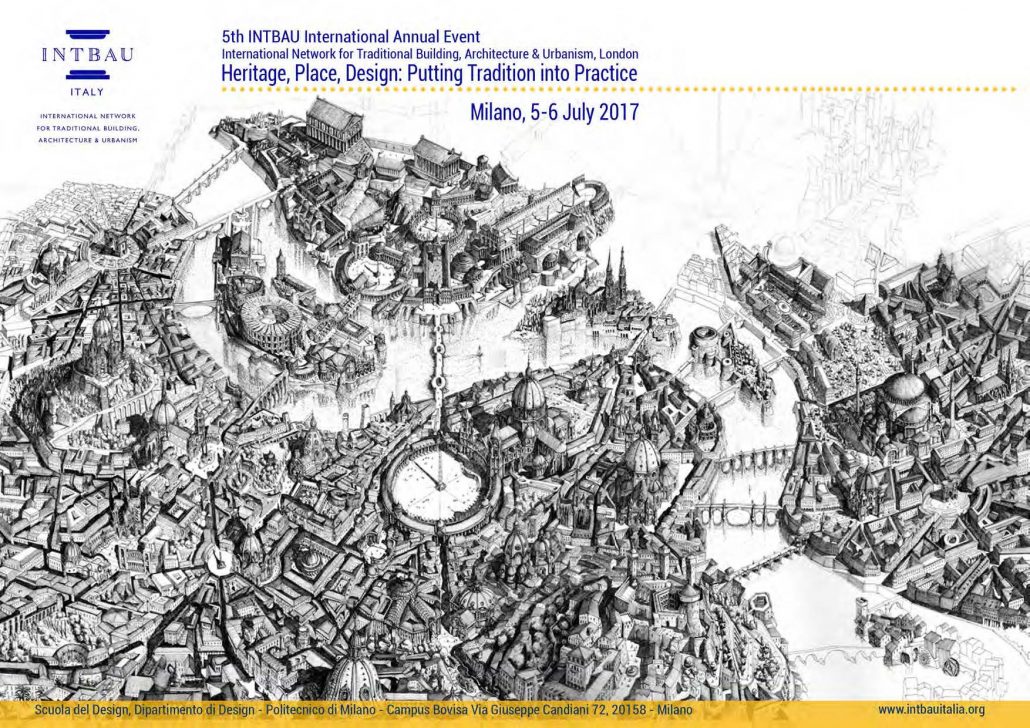
Participants will share case studies and current practice on the documentation of settlements that should be preserved, focusing on innovative solutions, design challenges in placemaking and identity conservation, cultural issues in heritage assessment, and the technical and craft expression of culture.
The conference aims to foster an international exchange of research, case studies and best practice to confront the challenges of designing places, building cultural landscapes and enabling the development of the community.
The three the topics of the conference are:
- Representation, documentation, visualization and communication of cultural heritage
- Traditional and regional architecture and their qualitative and constructive characters
- Cultural landscapes, place-making tools
26th CIPA Symposium Updates from Ottawa (Canada)
Excellent Keynotes and emerging youth professional travel grants
Exciting news from Ottawa:
- Chance Coughenour will be giving a keynote, he is the Program Manager at Google Arts & Culture coordinates cultural heritage preservation efforts on a global scale. He organizes partnerships and leads projects, which employ emerging technology for cultural heritage documentation and dissemination. Prior to joining Google, Chance participated in archaeological research and cultural heritage documentation projects throughout Europe and the Americas. He is also the co-founder of Rekrei, a volunteer, crowdsourcing project for destroyed heritage. He was previously a Marie Skłodowska-Curie fellow at the Institute for Photogrammetry at the University of Stuttgart in Germany;
- The Global Heritage Fund, in its endeavour to provide support to Emerging Professionals in Heritage Conservation, is offering three travel expense support grants to scholars attending the 26th CIPA Symposium in Ottawa (Canada). Any young (under 30 years old) participant who has submitted a paper to the symposium is eligible to apply for this support. Successful applicants will be reimbursed upon submitting expense receipts for travel to Ottawa. The selection panel will announce the successful awardees in April 2017. More information about the amount of support and application process will be provided soon;
- Iscan3D from Canada, a company devoted to record historic places is sponsoring and will be exhibiting during the symposium;
- Deadline for extended abstracts and papers approaching soon February 15, 2017. Do not forget to register for the symposium;
- Early registration ends Feb 1, 2017.
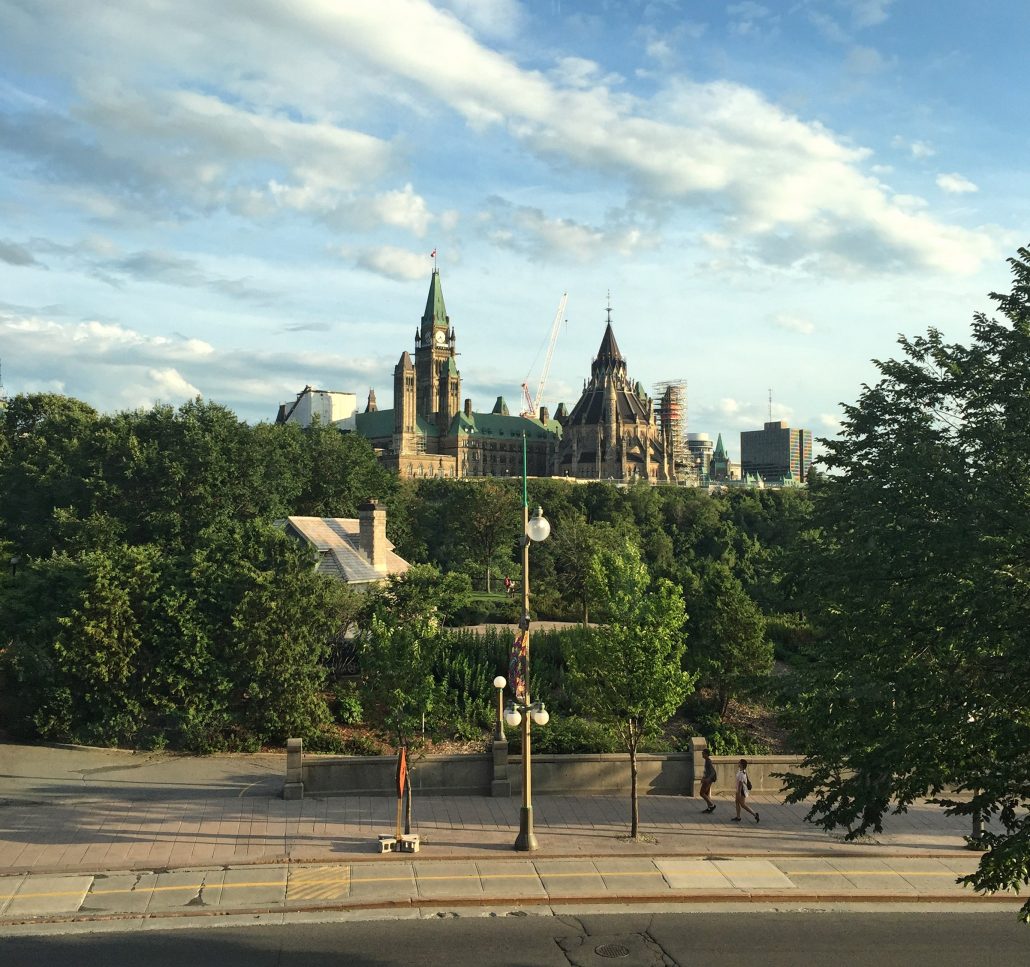
Mario Santana
info@cipaottawa.org
http://cipaottawa.org
Upcoming Joint Meeting in New Delhi, 2017
After disasters, information concerning the state of cultural heritage is essential. To share the information of cultural heritage conservation and coordinate protection efforts, CIPA will work cooperatively with ICORP and ISCARSAH, and hold a joint meeting during 2017 ICOMOS General Assembly in New Delhi, India. ICORP and ISCARSAH are two of the International Scientific Committees (ISCs) of ICOMOS. ICORP enhances disaster risk management and resilience for built cultural heritage; ISCARSAH serves as a network for experts in the field of conservation of heritage structures. Individually, they have been successful in their efforts to protect cultural heritage through conducting research, developing conservation theory, holding international conferences and training activities.
According ICOMOS principles, cross-disciplinary collaboration between ISCs has been encouraged. The idea of the three-ISCs collaboration can be traced back to April 2016. Afterward, in August, part of the members of the board, AG, MS, RE, AY and Gustavo Araoz, President of ICOMOS, made an initiative discussion and drafted a proposal. The partnership of the three ISCs was officially confirmed during the meeting of ICOMOS 2016 General Assembly in Istanbul this October. Through the close collaboration, CIPA, ICORP and ISCARSAH aim to share the resource such as research results and experts, making the network of cultural heritage conservation extended. A joint meeting will be held during 2017 ICOMOS triennial General Assembly in New Delhi, India. Future achievements of the cooperation are highly anticipated.
To promote the cooperation, CIPA, ICORP and ISCARSAH have appointed two representatives respectively; Mario Santana and Alex Yen will be on behalf of CIPA. The preparation for the preliminary work of 2017 joint meeting will be done by Professor Alex Yen and China University of Technology. Latest news and call for papers information are going to be released on the official website in the beginning of 2017. We look forward to your kind support.
Alex Yen
alexyen@cute.edu.tw
Agisoft PhotoScan – Professional photogrammetric kit
Agisoft LLC (www. agisoft.com) is an innovative research company with focus on professional photogrammetric software development. Agisoft PhotoScan, being run on a single desktop computer (Windows, Linux, Mac OS) or on a cluster for massive data management, enables the user to process digital images into the accurate spatial data, like Dense Point Clouds, Textured Polygonal Models, Georeferenced True Orthomosaics and DEMs.
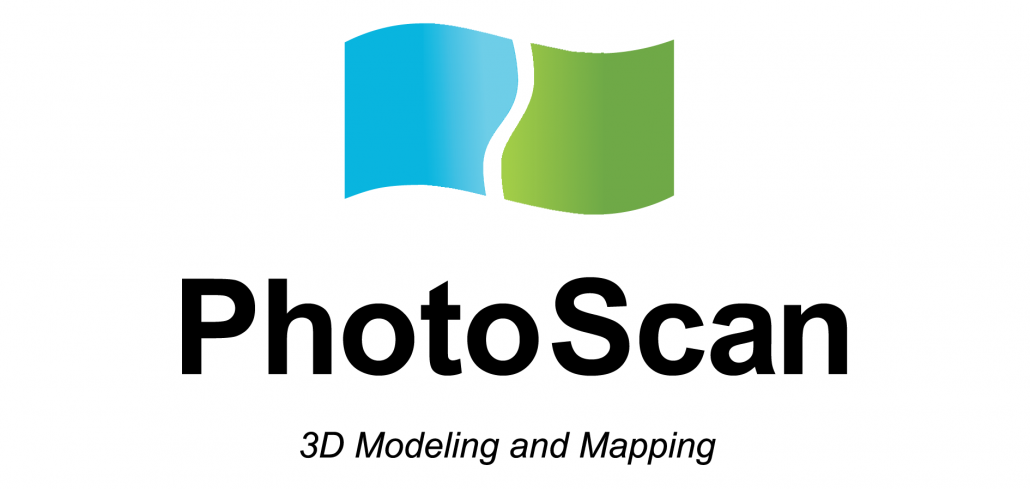
Agisoft PhotoScan software presents diverse and advanced functionality making the tool popular among the professionals in various fields. In the IJsselkogge project (The Netherlands, 2015-2016) PhotoScan has been used for the best-preserved medieval shipwreck ever found documentation both underwater and on land, with submillimeter accuracy having been achieved on the ship’s timbers models. Over 600 historical sites have been documented around South America, including the world-known Machu Picchu city, by Peru’s drone archeology team (founded in 2013), who has chosen PhotoScan software for the imagery processing. Taiwan’s National Cheng Kung University applied photogrammetry for the project of a different nature – inspection of the damage caused by an earthquake in Taiwan, Feb. 2016. Furthermore, urban management tasks are effectively solved with 3D models reconstructed for the entire cities, like the one generated for the city of Tomsk, Russia (320 km², 2014). Among the recent agricultural user cases, the project held in Central Russia can be named as an example of vegetation index calculation large scale tasks (1000 ha, 2015).
While all the kinds of applications mentioned above are accuracy-focused, PhotoScan is also employed in the fields where texture quality matters, namely game design and visual effects industries. Popular computer games (Star Wars Battlefront by EA Dice, The Vanishing of Ethan Carter by The Astronauts, The Talos Principle by Croteam) and films (Mad Max: Fury Road by Iloura, Edge of Tomorrow by Sony Pictures Imageworks, Lincoln by Framestore), have proven that PhotoScan photogrammetric software becomes an indispensable part of a designer’s work.
The Agisoft team constantly works on improvements for PhotoScan software to be an efficient solution for the tasks our users face.
Diana Ovod
diana.ovod@agisoft.com
http://www.agisoft.com
AICON – The Bernd Breuckmann Award:… and the winner is…
Awarded 3D Scanning Research Ideas 2016
For innovative 3D research work, AICON presents the ‘Bernd Breuckmann Award’ to acknowledge and support the best ‘3D Scanning Research Idea’ of a non-profit scanning project in the field of arts and cultural heritage. Participation is open to all applicants submitting a non-commercial project proposal in the area of arts and cultural heritage, i.e. archeology, arts, history, paleontology and any related disciplines. In particular, young generation scientists are encouraged to participate in this award invitation.
The winner of the Breuckmann Award 2016 is Erica Nocerino. The five-member jury selected Erica Nocerino’s ‚3D MASTER‘ as this year’s winning project. Capturing small and medium-sized artifacts requires not only fast scanning with high accuracy, but also the simultaneous recording of the high-resolution object texture – an ideal task for the SmartScan. In addition, Erica Nocerino aims at working out general rules and best practice methods with the 3D data to facilitate the mass digitalization in the field of arts and cultural heritage.
For her project Erica Nocerino (Fondazione Bruno Kessler, Trento, Italy) will be receiving with a SmartScan system on loan. AICON will provide this mobile, highly precise fringe projection scanner for her work in various museums in Sicily. The additional cash price to the amount of € 1,000 will help to cover part of her project expenses. We will keep you informed about the development of the project on our website.
Given the numerous high-quality applications submitted to the Breuckmann Award, the jury has decided to award an additional special prize again. This time, we will support ‚Tracking transport damages with 3D digitization‘as subproject of Carolin Heinemanns studies on the transport control of original paintings.In this third edition of the Breuckmann Award, the jurors were excited by the elaborate project proposals for 3D scanning projects. Dr. Dirk Rieke-Zapp, AICON Key Account Manager for Arts and Culture, explains: “The increased 3D digitization of historical objects is gaining more and more importance for research, for documentation and for museum exhibitions. We are happy to support this development with the AICON 3D Scanners and the Breuckmann Award.”
In this third edition of the Breuckmann Award, the jurors were excited by the elaborate project proposals for 3D scanning projects. Dr. Dirk Rieke-Zapp, AICON Key Account Manager for Arts and Culture, explains: “The increased 3D digitization of historical objects is gaining more and more importance for research, for documentation and for museum exhibitions. We are happy to support this development with the AICON 3D Scanners and the Breuckmann Award.”
Learn more about the Bernd Breuckmann Award!
The Parthenon’s sculptures and their plaster casts
New 3D scanning application report
The Parthenon‘s historic plaster casts displayed in the British Museum (London) function as important historical records; they may contain valuable archaeological information subsequently lost from the original sculptures. Sections molded include the West Frieze and part of the North Frieze. However, it is not unheard of for the 19th century plaster craftsmen (formatori) to doctor the casts; crafting their molds such that when cast, a damaged sculpture would appear more complete than the corresponding original. A doctoral thesis uses a SmartScan-HE to investigate this assumption by comparing the 3D models of some original classical sculptures of the Acropolis Museum (Athens) with the according 19th century plaster casts of the British Museum.
This project involves both 19th century plaster casts and the original classical sculptures from which they were produced. To study the current surface appearance and condition of casts and originals, the 3D data have to include even finest topographical details. The two 3D models shall be mapped onto each other to analyze any differences. The comparative 3D data shall facilitate interpreting the complex nature of the plaster surfaces by distinguishing between differences caused by reductive processes on the originals (e.g. weathering) and additive processes on the casts (made up by the formatori).
The 3D data shall be analyzed combined with digital photographs and/or reflectance transformation imaging (RTI), together with consideration of the historic context of both casts and originals, craft techniques used to produce the casts, and limitations of the scanning process when dealing with objects of two different materials (marble and plaster).
Below, you see Ms. Emma Payne and the SmartScan-HE at work in the British Museum’s exhibition (image courtesy of the British Museum, London).
![]()
Read more about workflow and results!
AICON 3D Systems at the CAA in Atlanta (USA)
Session track “Close-range 3D data acquisition, processing, querying and presentation in cultural heritage”
From March 14-16, 2017 the 45th CAA will focus on “Digital archaeologies, material worlds (past and present)”. This international conference will bring together scholars from across the globe to share their cutting edge research from a diverse range of fields.
Dirk Rieke-Zapp, AICON Key Account Manager Arts & Culture, will co-organize a session track on “Close-range 3D data acquisition, processing, querying and presentation in cultural heritage”. In addition, the company AICON 3D Systems and their partner Accurex will present the new scanner line PrimeScan, an attractive entry-level solution for highly precise digitization for applications in arts and cultural heritage. The PrimeScan is compactly designed: Its base area equals a DIN A4 sheet, the scanner weighs only 3 kg. With its short working distance, it is suitable as desktop solution and for applications with limited room. Measuring fields between 50 mm and 1,000 mm are available, the working distance is optimized for the spatial conditions of museums as well as of archaeological excavations.
AICON 3D Systems is the only manufacturer of high-end scanners with blue and white projection light, suitable for scanning all surface colors. A PrimeScan configuration with color cameras captures high-resolution image textures. The OptoCat Texture Mapping module allows mapping these data directly to the 3D models. Depending on the required resolution at the object and the favored accuracy, the PrimeScan cameras (monochrome or color) are available with resolutions of two, five or eight megapixel.
![]()
What do you want to capture with the PrimeScan?
About AICON 3D Systems
AICON 3D Systems is one of the world’s leading providers of optical camera-based 3D measuring systems. The company, founded in 1990, develops and distributes systems for the business areas of inspection and testing including car safety and tube inspection. Since the acquisition of Breuckmann GmbH in August 2012, the product range also includes scanners for 3D measurement of complex geometries. On 1 April 2016, the AICON 3D Systems GmbH has joined Hexagon Manufacturing Intelligence, a leading global provider of information technologies that drive productivity and quality across geospatial and industrial enterprise applications.
The digital acquisition and documentation of cultural masterpieces is increasingly gaining importance — be it in architecture, fine arts, archaeology or paleontology. The contact-free 3D scanning technology of Breuckmann Scanners works in the museum as well as at the archaeological site. It allows handling delicate objects with the utmost care and provides detailed 3D data with high-resolution color textures for thorough studies without using the original. The white-light scanners are not 3D measuring systems bought “off the rack”, but rather are characterized by their high degree of flexibility: The scanner configuration is adjusted exactly to the customer’s requirements.
For more information, please visit this site.
For regular updates on our products and 3D scanning projects in Arts & Culture, please subscribe to our newsletter.
Dirk Rieke-Zapp and Martina Maier
ac_newsletter@aicon3d.de
http://aicon3d.com/start.html
Getty Conservation Institute – Arches to be implemented in Greater London and Lincoln, UK
The Getty Conservation Institute is pleased to announce that Arches Version 4.0 will be released on March 24, 2017, and an Arches mobile data-collection app is planned to be released in late summer 2017. The Arches project will be holding a free workshop about all of the new features of Version 4 at the CIPA 2017 symposium in Ottawa. To find out more about the range of new features included in Version 4, including an installation wizard and built-in tools for configuration and customization, visit this page.

The GCI is also excited to now be working with Historic England and the City of Lincoln (England) to implement the Arches open source software platform for the Greater London and Lincoln Historic Environment Records (HERs). Through this initiative, the GCI will be making enhancements to the Arches platform based on the common needs of local heritage authorities in England. The enhanced software will serve as a means to create a version of Arches that will be freely available and can be readily applied by other cultural heritage organizations across the UK to configure and use as they see fit. Implementation of Arches by the two HERs will take place after the completion of Arches Version 4.0, and is expected to be launched in Lincoln by the end of 2017, and in London by the end of 2018.
To see a range of implementations of the Arches platform, visit this page. Learn more at the Arches website.
David Myers
dmyers@getty.edu
http://archesproject.org
IGD Fraunhofer – 3D Model of Berlin Pergamon Altar
July 05-06, 2017, Milano (Italy)
In September 2014, the Pergamon Altar in Berlin was scanned in 3D by the Competence Center Cultural Heritage Digitization at Fraunhofer IGD. The scanning project was implemented in cooperation with the Antiquities Collection of the Berlin State Museums (Antikensammlung der Staatliche Museen zu Berlin) and was supported by the German Federal Government Commissioner for Culture and the Media (Beauftragte der Bundesregierung für Kultur und Medien, BKM).
The result is an elaborated 3D model of the more than 2000-year-old Hellenistic altar. Now the masterpiece of Ancient Greece is at least accessible online, while the exhibition hall will be closed until 2019 due to renovation works. Since 2013, the Pergamonmuseum is being modernized section by section as part of the Master plan Museumsinsel (Masterplan Museumsinsel). The room with the Pergamon Altar has been closed for works since November 2014.
The Berlin State Museums (Staatliche Museen zu Berlin) commissioned the scanning project at short notice. Nevertheless, the entire altar could be scanned in 3D within the last two weeks before closure. Planning the task took up the first, implementing the scanning process the second week. All on-site works could be completed on the last day of opening, September 29, 2014.
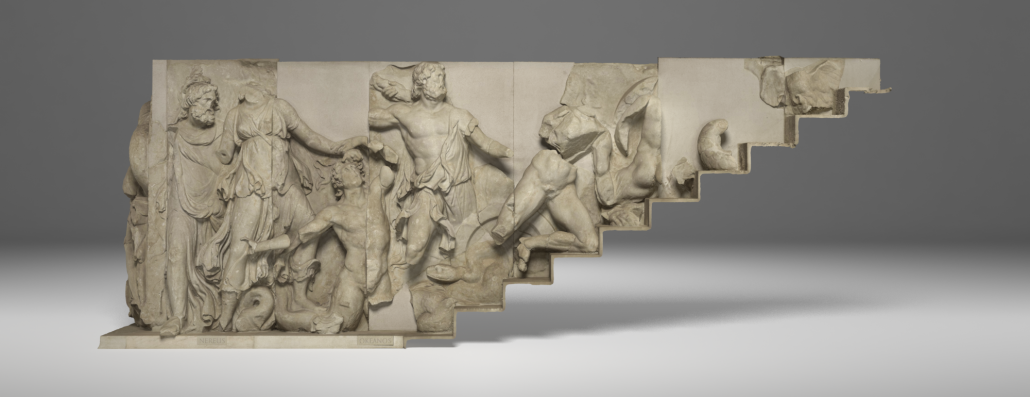
For the visual acquisition of the cultural artifact, Pedro Santos and his team used a laser scanner, which was placed in 51 different positions and which recorded a total of 176 million 3D points per measurement. The 113m long Gigantomachy frieze was photographed automatically with a reflex camera. In order to capture the frieze in its height, this camera was mounted onto an 8m long, mobile rig with a flexible tilt head; a solution that originates from film technology. Subsequently, the photogrammetric and the photo-optic pictures were combined to form the 3D model. This model consists of 83 million triangles from the laser scan and 500 million triangles from the frieze scan and therefore comprises a total of about 580 million triangles. A 3D visualization of such high resolution makes a true-to-original and detailed representation of the altar possible.
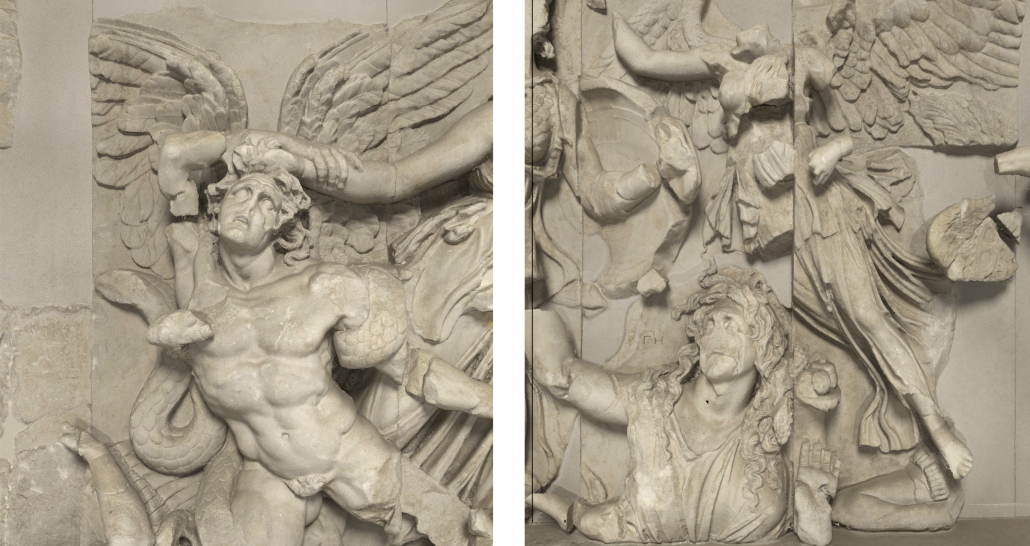
The Pergamon Altar’s 3D model has been available to the public since May 24, 2016. In an online viewer, the entire architectural ensemble can be examined in detail. This virtual representation also offers information on the iconographic program. The 3D model thereby creates access to the currently inaccessible original. Furthermore, the model is now available for numerous applications in research, museum presentation, or reproduction. A hybrid exhibition, which displays the 3D model during the modernization phase, is already being planned. Another possibility to continue work in this direction would be with regard to the fragments of the altar, which are currently stored at the depot of the Antiquities Collection. Should these artifacts be scanned as well, the models could help to virtually piece the altar back together like a puzzle. From a conservation point of view, 3D visualization can make a contribution that exceeds the purely documentary purpose.
Visit the Pergamon Altar in 3D here.
